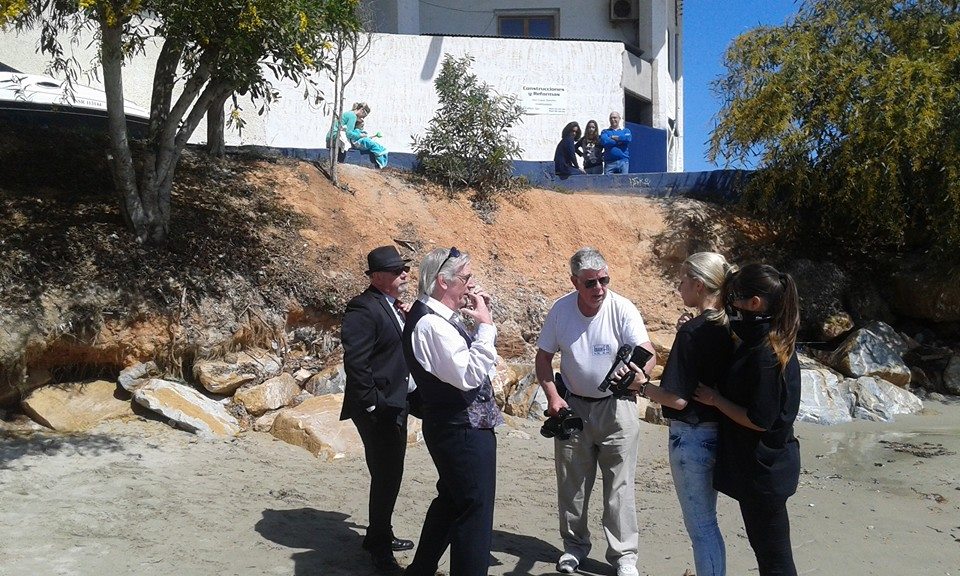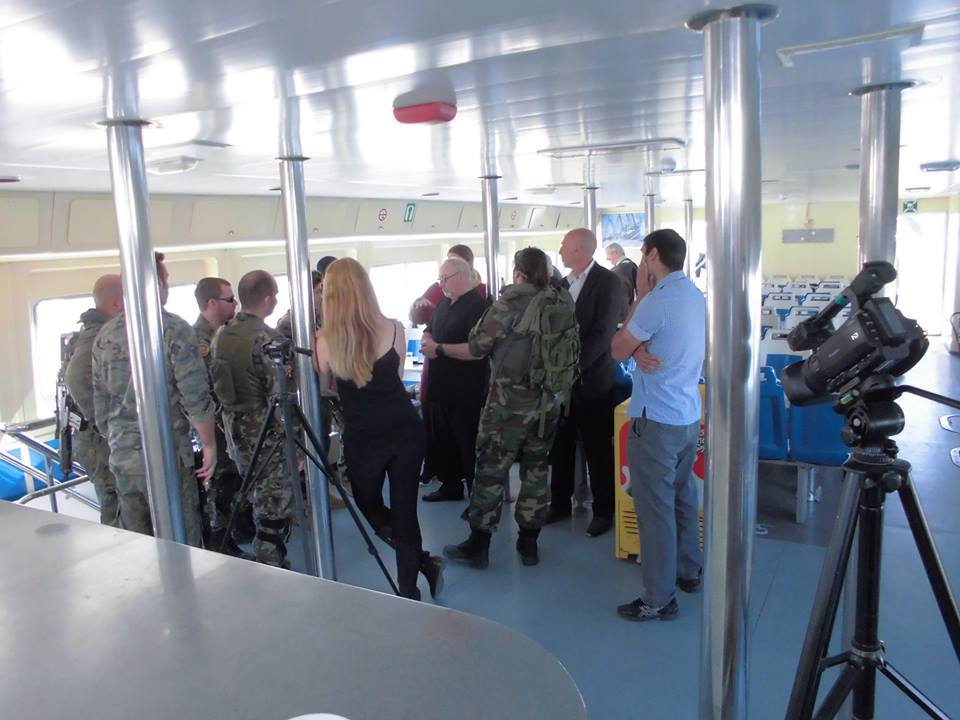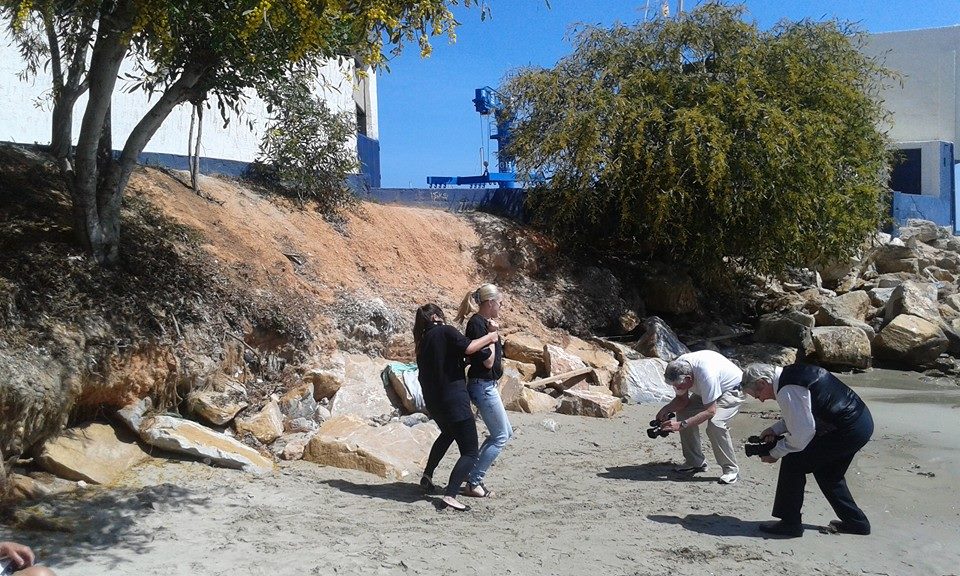 If you've been paying attention to the posts about The Cucaracha Club - Torrevieja's first full length feature film, using local locations, services and actors - you'll get some idea of just how remarkable the whole project is. However, when you delve deeper into the back stories, you come to realise that the production team have achieved the impossible and worked miracles, often in the face of adversity and sheer bloody mindedness. Or at least, that's what I came away with after chatting to director Rai Woods and Executive Producers Billie Anthony Gaddess and Clive Gray recently.
If you've been paying attention to the posts about The Cucaracha Club - Torrevieja's first full length feature film, using local locations, services and actors - you'll get some idea of just how remarkable the whole project is. However, when you delve deeper into the back stories, you come to realise that the production team have achieved the impossible and worked miracles, often in the face of adversity and sheer bloody mindedness. Or at least, that's what I came away with after chatting to director Rai Woods and Executive Producers Billie Anthony Gaddess and Clive Gray recently.
You'd think the hardest part would be getting the idea for the story line, then writing the script - especially if, like Billie, you've never written a screenplay before. He collaborated with Philip Routledge, after his first collaborator stole the script, took it to Madrid, and then tried to sell it back to Billie. Unfazed, he came up with a new plot line, and enlisted Philip's help to put the story together, rather than pay to get his own work back. So, now there's a script, all you have to do is hand it over to the production team to make it into a movie, right? Not exactly - this was what Billie tried to do in the first instance, and he even managed to persuade the team to work for free. However, just five weeks before shooting was due to start, the film crew pulled out with no real explanation, or, as Clive Gray so succinctly put it:
Our expertise just ebbed away.
For any sensible person, that would have been the end of that. Dream over. It's not meant to happen.  There was no budget for the film, and nobody experienced to put behind the cameras other than Rai Woods, who had worked with the best directors in the business, including John Schlesinger and Clive Donner during more than 30 years of broadcasting in the UK, but had never directed a full length feature film before. Billie had never been on the business end of a movie camera either, and Clive had an interest in photography, but no intention of progressing into the movies. Until with five weeks to go, there was no other option but to shoot the film themselves. Fortunately for the sake of the film - and everyone who is likely to enjoy it in the future - Billie, Clive and Rai do not fit into the 'Sensible' category!
There was no budget for the film, and nobody experienced to put behind the cameras other than Rai Woods, who had worked with the best directors in the business, including John Schlesinger and Clive Donner during more than 30 years of broadcasting in the UK, but had never directed a full length feature film before. Billie had never been on the business end of a movie camera either, and Clive had an interest in photography, but no intention of progressing into the movies. Until with five weeks to go, there was no other option but to shoot the film themselves. Fortunately for the sake of the film - and everyone who is likely to enjoy it in the future - Billie, Clive and Rai do not fit into the 'Sensible' category!
The guys may not be sensible, but they are practical, and Clive registered Siesta Productions as a UK company in readiness for the filming. Why a a UK company? Because it can be done within an hour, and then you have the paperwork that is necessary to open doors and get permission for filming in various locations. The Spanish love of bureaucracy means that setting up a company can take weeks, or even months, and the production team had just 5 weeks, and the clock was ticking.
It took another two weeks to find the €23,ooo they needed to get the equipment they needed for filming and pay for various vital services for the production, so by the time everything was in place, Clive had just a week to 'play with the cameras' before filming started. Oh, and most of the budget came from Billie and Clive, so this was a giant leap into the unknown. However, as Clive said:
The only choice we really had was to stump up and learn as we went along. That's why all the shots were either simple or static.
That takes away from the fantastic achievement of getting their first film shot within six months. Clive's a bit of a statistician, and he reckons that it took 50 hours hours of screen footage to get 90 minutes in the can. As the average is 70 hours - even for an experienced production crew who aren't learning as they go along and aren't so restricted on budget - that's pretty good going. Even something ostensibly simple like recording the title song can take a lot more work than the few minutes on screen would suggest. Chloe Leigh sung the song about 15 times, the shooting took around 10 hours, and it was a week later before the music video was edited and ready to roll.
But the biggest problem of all was keeping continuity flowing. The film was shot over 6 months, and in that time, things change. Although the weather is pretty reliable here on the Costa Blanca, hedges grow and get cut, hair grows and/or gets cut, people buy new curtains or paint their doors, and swimming pools are filled and emptied. It's not something most people would think about, but you have to consider it all when you're making a movie.
time, things change. Although the weather is pretty reliable here on the Costa Blanca, hedges grow and get cut, hair grows and/or gets cut, people buy new curtains or paint their doors, and swimming pools are filled and emptied. It's not something most people would think about, but you have to consider it all when you're making a movie.
Clive remembers going back to Breakaways bar in Villamartin to shoot a follow on scene, and noticing that the tables were all in different places, yet the scene was supposed to take place on the same day. Tables can be a bit naughty and rearrange themselves when nobody's looking, so Clive had to go back and look at the previous scene, then dress the set so it was identical. You can suspend belief and stretch credibility in the movies - but not to the extent that tables do a tango between scenes. Not only that, but the soup tureen and bottles and glasses had to be in the same place, and the posters in the windows had to be the same. In all, it took an hour to dress the set for just two minutes of movie time.
Rai emphasises just how demanding life on set could be for Clive - he was acting, he was also in charge of continuity, and he was working the cameras as well. Each of those is a pretty major job on its own, but Clive took it all in his stride - even though it often meant working from 7.00 am until 2.00 am, and then starting again. On a quiet day, he could get away with putting just 10 hours in, and he was still running three different businesses at the same time.
When Clive first agreed to work on The Cucaracha Club, he thought he'd be acting in 19 of the film's 60 scenes. He ended up being there for every one, every day for six months, either acting, working on camera, or doing both! Reviewing the film footage from the September day when the crew shot the scenes on the Delfin submarine with the temperature at 40 degrees outside and 50 inside, Clive spotted himself, squeezed into the Captain's bunk with his camera, filming Tom Watt and sweating not very prettily. As he said, it was all a case of learning as they went along. Time was tight too, because the filming was scheduled for the morning, and the Delfin was open to the public in the afternoon!
Billie faced different problems - mainly with the cast, and getting everyone in the right place at the right time for their scenes. The reason the cast was largely drawn from the Torrevieja area was because, as Clive emphasised:
The Cucaracha Club isn't just a film made in Torrevieja, it's a total Torrevieja production, using local people, places and services. It's the first film entirely produced in the area - others have followed, but Siesta Productions led the way.
For Billie, it was an ideal opportunity for local actors to have their talent recognised and used in other productions in the area, such as the hit sitcom Benidorm. At the moment, the only way local actors get a shout is if they carry a tray or lounge by the pool, as the production company tends to bring in big names for the speaking parts. In The Cucaracha Club, the local talent certainly showed what they could do, but not everyone took the opportunity as seriously as they should have. Acting in a film is very different to appearing on stage, and some of the actors had to be discouraged from thigh-slapping and the sort of stuff that is okay in a pantomime but not appropriate in a spy thriller.
Then there were the ones who 'Had to be away by 12,' or had some other reason that often meant re-shooting scenes with different actors. That's not going to be a problem in The Cucaracha Club 2 - anyone who wants to appear will have to commit to being on set when they are needed. It's just one of the many things the guys have learned along the way. Now the film is in the can and ready for release, Siesta Productions and Billie, Rai and Clive are earning respect and gaining credence as film makers.
 To round off the interview, I asked what was the most remarkable thing that happened during production. In a story that's full of surprises and superlatives, the answer was another shocker. When Eon Productions - who make the James Bond films - asked for permission to film in Real Club Nautico Torrevieja's marina, they were refused. However, RCNT had no problem in granting pretty much unlimited access to all areas to Siesta Productions. Why was that? Nobody associated with the film is certain, so it's just speculation, but maybe they wanted to help the new kids on the block because they admired their determination, or maybe it was because the film proudly promotes Torrevieja. Whatever the reason, Cubby Broccoli is probably spinning in his grave to think that George Ramshaw (Billie's character) got to shoot his way out of Torrevieja Marina while James Bond was turned away!
To round off the interview, I asked what was the most remarkable thing that happened during production. In a story that's full of surprises and superlatives, the answer was another shocker. When Eon Productions - who make the James Bond films - asked for permission to film in Real Club Nautico Torrevieja's marina, they were refused. However, RCNT had no problem in granting pretty much unlimited access to all areas to Siesta Productions. Why was that? Nobody associated with the film is certain, so it's just speculation, but maybe they wanted to help the new kids on the block because they admired their determination, or maybe it was because the film proudly promotes Torrevieja. Whatever the reason, Cubby Broccoli is probably spinning in his grave to think that George Ramshaw (Billie's character) got to shoot his way out of Torrevieja Marina while James Bond was turned away!
The Cucaracha Club has now been granted a 12A certificate by the British Board of Film Classification. It's scheduled for showing in Torrevieja early in 2017, and negotiations are in progress to arrange the British Premiere before the film goes on general release.
Photo credits: Clive Gray's collection, on set filming The Cucaracha Club
There's lots more about The Cucaracha Club and life in Spain at Sandra in Spain.com